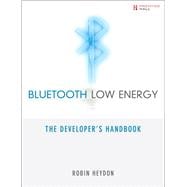
What is included with this book?
Acknowledgments
About the Author
Part I: Overview
Chapter 1: What is Bluetooth low energy
1.1 Device Types
1.2 Design Goals
1.3 Terminology
Chapter 2: Basic Concepts
2.1 Button Cells
2.2 Time is Energy
2.3 Memory is Expensive
2.4 Asymmetric Design
2.5 Design For Success
2.6 Everything Has State
2.7 Client Server Architecture
2.8 Modular Architecture
2.9 One Billion Is A Small Number
2.10 Connectionless Model
2.11 Paradigms
Chapter 3: Architecture
3.1 Controller
3.2 Host
3.3 Application
3.4 Stack Splits
Chapter 4: New Usage Models
4.1 Presence Detection
4.2 Broadcasting Data
4.3 Connectionless Model
4.4 Gateways
Part II: Controller
Chapter 5: Physical Layer
5.1 Background
5.2 Analog Modulation
5.3 Digital Modulation
5.4 Frequency Band
5.5 Modulation
5.6 Radio Channels
5.7 Transmit Power
5.8 Tolerance
5.9 Receiver Sensitivity
5.10 Range
Chapter 6: Direct Test Mode
6.1 Background
6.2 Transceiver Testing
6.3 Hardware Interface
6.4 Direct Testing with HCI
Chapter 7: Link Layer
7.1 Link Layer State Machine
7.2 Packets
7.3 Packet Structure
7.4 Channels
7.5 Finding Devices
7.6 Broadcasting
7.7 Creating Connections
7.8 Sending Data
7.9 Encryption
7.10 Managing Connections
7.11 Robustness
7.12 Optimizations for Low Power
Chapter 8: Host Controller Interface
8.1 Introduction
8.2 Physical Interfaces
8.3 Logical Interface
8.4 Controller Setup
8.5 Broadcasting & Observing
8.6 Initiating Connections
8.7 Connection Management
Part III: Host
Chapter 9: L2CAP
9.1 Background
9.2 L2CAP Channels
9.3 L2CAP Packet Structure
9.4 LE Signaling Channel
Chapter 10: Attributes
10.1 Background
10.2 Attributes
10.3 Grouping
10.4 Services
10.5 Characteristics
10.6 Attribute Protocol
10.7 Generic Attribute Profile
Chapter 11: Security
11.1 Security Concepts
11.2 Pairing & Bonding
11.3 Signing of Data
Chapter 12: Generic Access Profile
12.1 Background
12.2 GAP Roles
12.3 Modes and Procedures
12.4 Security Modes
12.5 Advertising Data
12.6 GAP Service
Part IV: Application
Chapter 13: Central
13.1 Background
13.2 Discovering Devices
13.3 Connecting to Devices
13.4 What does this device do?
13.5 Generic Clients
13.6 Interacting with Services
13.7 Bonding
13.8 Changed Services
13.9 Implementing Profiles
Chapter 14: Peripheral
14.1 Background
14.2 Broadcast Only
14.3 Being Discoverable
14.4 Being Connectable
14.5 Exposing Services
14.6 Characteristics
14.7 Security Matters
14.8 Optimizing for Low Power
14.9 Optimizing Attributes
Chapter 15: Testing and Qualification
15.1 Starting a Project
15.2 Selecting Features
15.3 Consistency Check
15.4 Generating a Test Plan
15.5 Creation of a Compliance Folder
15.6 Qualification Testing
15.7 Qualify Your Design
15.8 Declaring Compliance
15.9 Listing
15.10 Combining Components
Index
The New copy of this book will include any supplemental materials advertised. Please check the title of the book to determine if it should include any access cards, study guides, lab manuals, CDs, etc.
The Used, Rental and eBook copies of this book are not guaranteed to include any supplemental materials. Typically, only the book itself is included. This is true even if the title states it includes any access cards, study guides, lab manuals, CDs, etc.